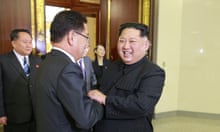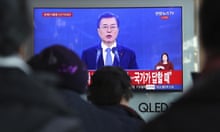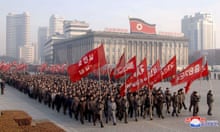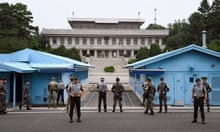North Korea has claimed that the rocket it test-fired on Wednesday morning is a new type of intercontinental ballistic missile that can strike anywhere on the US mainland, as it declared itself a “complete” nuclear state.
In a special announcement broadcast on state TV, the regime said it had successfully tested a Hwasong-15, which appears to be an advanced version of ICBMs it launched in July.
Q&AWhat do we know about the Hwasong-15 missile?
Show
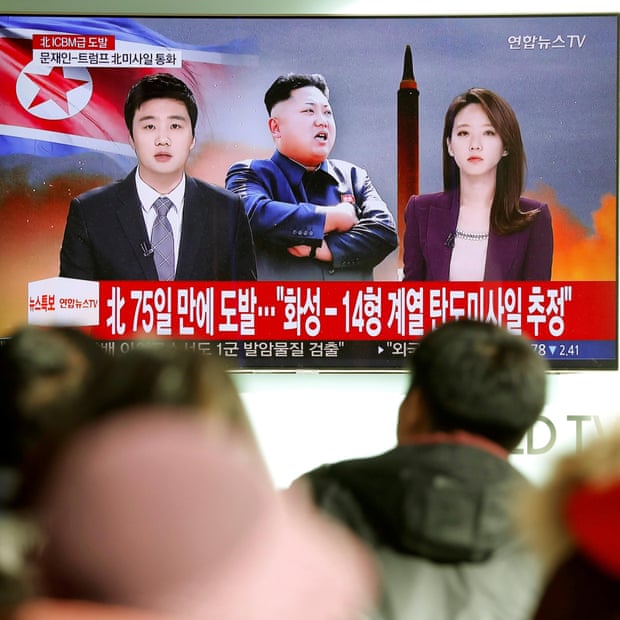
The Hwasong-15 missile fired on 29 November flew on a steep trajectory for 50 minutes, reaching an altitude of 2,800 miles (4,500 km) and distance of 620 miles, according to North Korea.
The US-based Union of Concerned Scientists said that if the numbers were correct, then the missile would have a range of 8,080 miles on a standard trajectory. That figure suggests that all of the US could theoretically be within range.
The missile appears to be an advanced version of the Hwasong-15 ICBM tested in July by North Korea, which claims this version makes it a "complete" nuclear state.
Pyongyang has not, however, proved it has the capability to marry a miniaturised nuclear warhead with a long-range missile and send it at a trajectory that would hit US cities.
It also remains unclear whether the North Koreans have perfected a re-entry vehicle capable of protecting a nuclear warhead during its descent.
A government statement, read out by the TV presenter Ri Chun-hee, quoted the country’s leader, Kim Jong-un, as saying: “Now we have finally realised the great historic cause of completing the state nuclear force, the cause of building a rocket power.”
Kim oversaw the launch in Pyongsong, about 18 miles north of the capital, Pyongyang. The official KCNA news agency said the missile was more sophisticated than any previously tested and was capable of carrying a “super-large heavy (nuclear) warhead”.
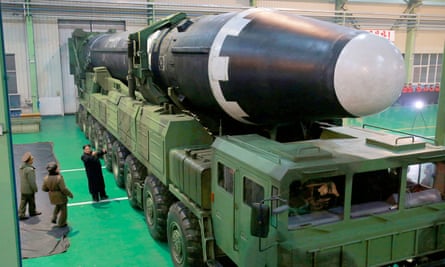
The regime’s claims have not been independently verified, but experts had been expecting North Korea to demonstrate that it now has all of the US in range – a development that significantly strengthens its position in any negotiations with Washington over its nuclear weapons programme.
Pyongyang has not, however, proved it has the capability to marry a miniaturised nuclear warhead with a long-range missile and send it at a trajectory that would put US cities in its sights.
Q&AWhy does the North Korean regime pursue a nuclear programme?
Show
Much of the regime’s domestic legitimacy rests on portraying the country as under constant threat from the US and its regional allies, South Korea and Japan.
To support the claim that it is in Washington’s crosshairs, North Korea cites the tens of thousands of US troops lined up along the southern side of the demilitarised zone – the heavily fortified border dividing the Korean peninsula. Faced with what it says are US provocations, North Korea says it has as much right as any other state to develop a nuclear deterrent.
North Korea’s leader Kim Jong-un is also aware of the fate of other dictators who lack nuclear weapons.
South Korea and Japan led condemnation of North Korea’s launch of the missile, which landed off Japan’s coast.
The launch, which triggered a South Korean test-launch in response, reignited tensions in the region after a lull of more than two months.
It was North Korea’s 20th launch of a ballistic missile this year, and possibly its third successful test of an ICBM following two launches in July.
Moon Jae-in, the South Korean president, voiced concern that North Korea’s perfection of an ICBM would send regional security “spiralling out of control” and lead the US to consider launching a pre-emptive strike.
Wednesday morning’s launch adds to fears that North Korea will soon have a military arsenal that can viably target the US mainland.
Japan’s prime minister, Shinzo Abe, condemned the missile launch as “intolerable” and called for an emergency meeting of the UN security council. Within hours of the test, Abe and Donald Trump agreed to strengthen their defence capability and to urge China – North Korea’s main ally – to apply more pressure on Pyongyang over its weapons programme.
China expressed “grave concern” at the test, while calling for all sides to act cautiously.
The missile was reported to have flown for 50 minutes on a very high trajectory, reaching 2,796 miles (4,500km) above the earth (more than 10 times higher than the orbit of the International Space Station) before coming down nearly 621 miles from the launch site off the west coast of Japan.
This would make it the most powerful of the three ICBMs North Korea has tested so far.
David Wright, a physicist and missile expert at the Union of Concerned Scientists, calculated that on a normal trajectory, rather than a high lofted trajectory, the missile would have a range of 8,078 miles, enough to reach Washington, the rest of the US west coast, Europe or Australia.
Furthermore, the mobile night launch appeared aimed at testing new capabilities and demonstrating that Pyongyang would be able to strike back after any attempt at a preventative strike against the regime.
Q&AWhy is the timing and location of the launch significant?
Show
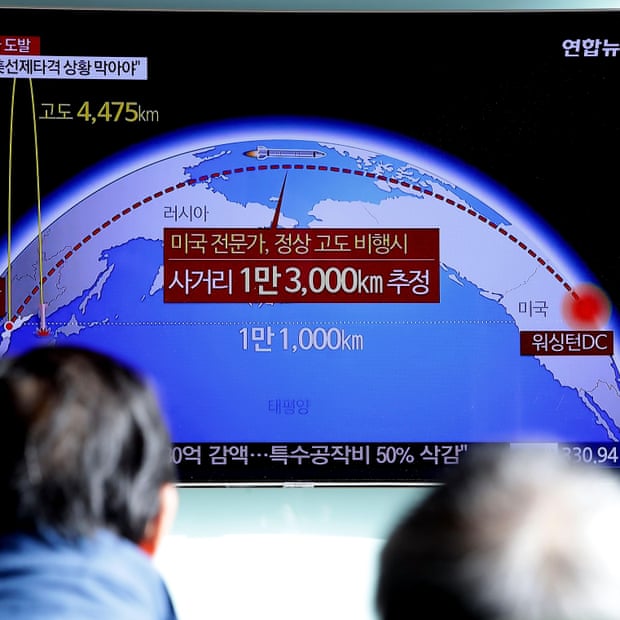
North Korea launched the missile from Pyongsong, in South Pyongan province, about 18 miles north of the capital, Pyongyang. It was the first time a missile had been fired from this location.
Unlike many other tests that usually occur in early morning, Wednesday's launch happened at around 2.28am local time (6.17pm GMT), most likely from a mobile launcher.
The timing and location are important because they indicate that North Korea was trying to show it can launch a missile whenever and from wherever it wants. Such capability makes it harder to take pre-emptive action – it is impossible to destroy a North Korean missile on a launch pad if the missile can be moved and there is no actual launch pad.
“It went higher, frankly, than any previous shot they’ve taken,” James Mattis, the US defence secretary, told reporters. “It’s a research and development effort on their part to continue building ballistic missiles that can threaten anywhere in the world.”
President Trump, who had insisted that North Korean development of an ICBM would not happen during his presidency, said: “We will take care of it … it is a situation that we will handle.”
Within minutes of the launch, the South Korean joint chiefs of staff announced Seoul had carried out an exercise involving the launch of a “precision strike” missile, signalling that it was primed to respond immediately to any attack from North Korea.
Rex Tillerson, the US secretary of state, condemned the launch and added: “Diplomatic options remain viable and open, for now. The United States remains committed to finding a peaceful path to denuclearisation and to ending belligerent actions by North Korea.”
It was the first North Korean ballistic missile test since 15 September and followed a warning earlier this month from Trump that North Korean threats to strike the US and its allies would be a “fatal miscalculation”.
The launch also marked a rebuff to Russia, which had claimed the previous day that the pause in missile launches suggested that Pyongyang was ready to defuse tensions in line with a proposal from Moscow and Beijing that North Korea could freeze missile and nuclear tests in exchange for a scaling down of US and allied military exercises.
“I think North Korea’s restraint for the past two months is within the simultaneous freeze road map,” said Igor Morgulov, the deputy Russian foreign minister, speaking to reporters in Seoul on Monday.
North Korean state media said the regime’s missiles “would not pose any threat to any country and region as long as the interests of [North Korea] are not infringed upon. This is our solemn declaration.”
Melissa Hanham, a senior research associate with the East Asia Nonproliferation Programme of the Middlebury Institute, said the statement could be an opportunity for Pyongyang and Washington to lower the diplomatic temperature.
“Perhaps this is an out,” Hanham wrote on Twitter. “A way to say they’ve achieved what they want, as long as we treat them the way they want to be treated.
“Diplomacy is worth the risk of failure, because to not engage them just gives them time to scale up.”
